S
Subhash Kak
Guest
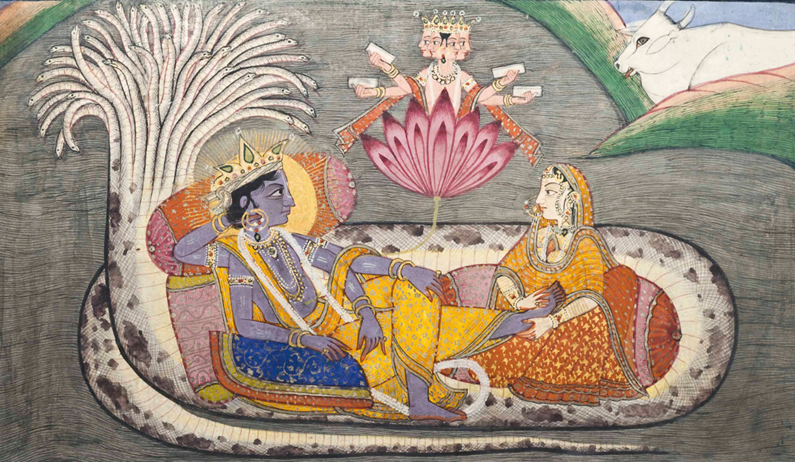
Anantaśāyin Viṣṇu and Lakṣmī with Brahmā emerging from his navel (mid-19th century, Himachal Pradesh)
There is no time without space, and no space without time. Reality is existence (sat), consciousness (cit), and our capacity to make sense of it (ānanda). These three, in their universal forms, are represented by Viṣṇu, Śiva, and the Goddess, and behind each lurks the mystery of time.
Since we live within time, it is hard to think of what it means, excepting the noting of big events like birth and death. What hangs in between these two gets progressively hazier and indistinct, before getting rubbed out altogether.
We sense time either at the level of personal experience, as awareness that we are conscious. If there were no conscious beings, the question of time and reality become meaningless.
Our mental conceptions spring either from the mind, from places, or the sky. There is magic in nature that provides comfort. Then there are grand thoughts like Mt. Kailāsa as the axis of the earth, or at Śivarātri, at dawn, the Sun (as Śiva) appearing with the crescent moon just above the disk and the Milky Way (Ākāśagaṅgā) in the background.
Atharvaveda 19.53 has a hymn on Kāla (Time) as the source of all there is:
sá evá sáṃ bhúvanāny ā́bharat sá evá sáṃ bhúvanāni páry ait /
pitā́ sánn abhavat putrá eṣāṃ tásmād vaí nā́nyát páram asti téjaḥ //4//
kāló ‘mū́ṃ dívam ajanayat kālá imā́ḥ pr̥thivī́r utá /
kālé ha bhūtáṃ bhávyaṃ ceṣitáṃ ha ví tiṣṭhate //5//
He [Time] surely brought here all the worlds, he surely encompasses all the worlds. Although their father, he became the son; there is, truly, no other force, higher than he.||4||
Kāla created the heavens, Kāla also created this earth. That which is past, and that which shall be, is ruled by Kāla, and rests on it.||5||
The notion of time as father becoming the son speaks to the recursive nature of manifestation. It creates our sense of aloneness as in these two lines by Dharmakīrti (7th century):
vahati na puraḥ kaścit paścān na ko ‘py anuyāti māṃ
na ca navapadakṣuṇṇo mārgaḥ kathaṃ nv aham ekakaḥ |
No one walks before, no one comes behind me;
no fresh footprints on the path. Could it be that I’m alone?
One fears aloneness, but it could also signify freedom and power as Patañjali informs us.
Viṣṇu sleeping on Ananta
Viṣṇu is existence as a whole, but what was there before the universe came into being? Since the universe can’t manifest out of nowhere, there ought to be a cycle to its appearance and dissolution, back into Viṣṇu. Poetically, when existence is dormant, Viṣṇu lies on the rock (naga) of what remains (śeṣa); this is pictured as Viṣṇu sleeping on the snake (nāga means snake) called Ananta (Infinity), for within the residue rests the potential for all creation.
When the physical world emerges, the process is set forth by Brahmā, the efficient cause, who emanates from Viṣṇu’s navel. Viṣṇu is the world’s moral order and as it decays, he must appear in a new avatāra to reestablish it.
Time is a part of space in the Viśvarūpa form of the Bhagavad Gītā, for in the transcendent all opposites merge.
Śiva’s dance
Consciousness is central to our sense of self. Śiva (Īśvara) is the light of consciousness not just for the Śaivas, but also for the Vaiṣṇavas, as in the Bhagavad Gita 13.23 where Krishna uses the term Maheśvara.
In consciousness inhere both birth and death (even at the level of thoughts) as described in Śiva’s dance.
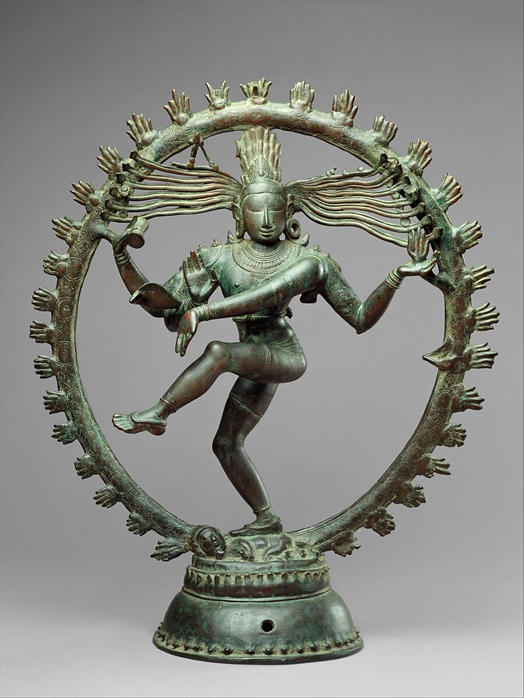
Śiva Naṭarāja (Chola period, 11th century)
Śiva Naṭarāja (“Lord of Dance”) combines in a single image the roles as creator, preserver, and destroyer. Śiva’s right hand holds the ḍamaru (from which emanate the sounds of creation); the upper left hand has agni (the fire that will destroy the universe); and with the lower right hand, he makes the abhayamudrā (the gesture that allays fear). The figure being trampled by the right foot is apasmāra puruṣa (the dwarf of illusion and ignorance). The front left hand, pointing to the raised left foot, signifies refuge. The energy of the dance makes his hair fly to the sides. The symbols imply that through faith Śiva’s devotees can achieve salvation.
His matted locks are whirling as he dances within an arch of flames representing the endless cycle of birth and death. On his head is a skull, which symbolizes his conquest over death. Goddess Gaṅgā, representing both the terrestrial river and the Milky Way, sits on his hair. His third eye is symbolic of his omniscience, insight, and enlightenment. The image rests on a lotus pedestal, the symbol of the creative forces of the universe.
The dance summarizes the five manifestations of reality: sṛṣṭi (creation); sthiti (preservation, support); saṃhāra (destruction); tirobhāva (concealment); and anugraha (grace). This dance takes place every moment and to every scale.
The cosmic frame
Time is a cave: we enter it in multiple ways. In addition to the daily and the annual cycles, there is earth’s precession that causes seasons to shift one month each zodiac sign in about 2,000 years (the precessional period is about 26,000 years). In nakṣatras, the shifting is one nakṣatra about 1,000 years, for there are 27 nakṣatras rather than 12 Zodiacal signs.
For the shifting of the spring equinox, which was the marker for the New Year as representing regeneration, here’s a list of changes with respect to the nakṣatras during the last 7000 years.
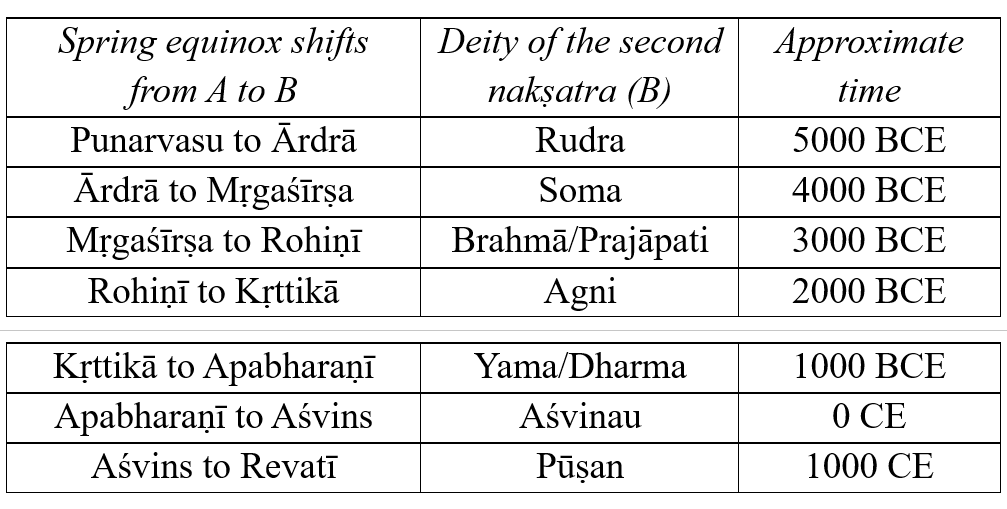
Shifting spring season with nakṣatra
Note that Ārdrā (“moist”) is Betelgeuse; Mṛgaśīrṣa (“deer’s head”) is Orion; Rohiṇī (“ascendant”) is Aldebaran; Kṛttikā (“cutters”) is the Pleaides, who are viewed as the nurses of Kārttikeya, the elder son of Śiva. The movement of the spring equinox is thus in nakṣatra names from Ārdrā to Mṛgaśīrṣa to Rohiṇī to Kṛttikā as shown below. It is a movement in consciousness: from Rudra (Śiva’s fierce form) to Candra (Moon worn by Śiva), to Prajāpati (Śiva’s father-in-law), and then to Agni (which is another form of Śiva).
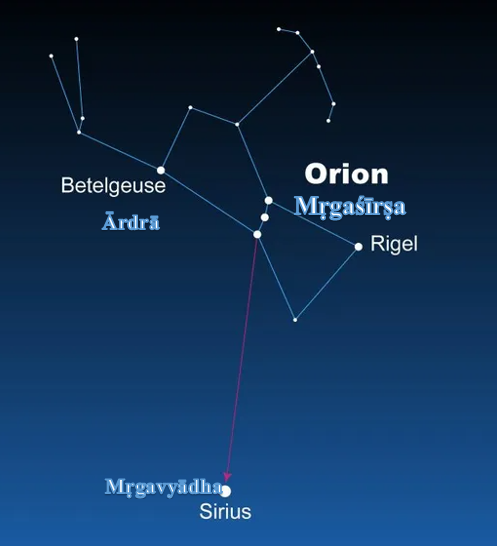
Ārdrā, Mṛgaśīrṣa, Mṛgavyādha
Dakṣa Prajāpati
The brightest star in the night sky is Sirius (Canis Majoris). In Sanskrit it is known as Mṛgavyādha, the “deer-hunter”, or simply “hunter”, Lubdhaka.
To find the place of Sirius, just draw a line from the belt of the conspicuous constellation Orion, Mṛgaśīrṣa, “deer’s head”, away from the ecliptic. Following Orion is Rohiṇī (Aldebaran) whose divinity is Prajāpati.

The red line marks the shift of the equinox: Ārdrā, Orion, Rohiṇī, Kṛttikā
Orion is also called Āgrahāyaṇī. In 1893, Bal Gangadhar Tilak wrote a famous book, Orion, in which he suggested that the name Āgrahāyaṇī meant that the year began with this nakṣatra and from this name the Western name Orion is derived, which is known in its earliest form in Greek as Ὠρίων, Ōríōn. Later, due to precession, the spring equinox marking the beginning of the year shifted to Rohiṇī.
The authors of the Aitareya Brāhmaṇa (AB) spoke about it as a riddle. Instead of saying that Time (Prajāpati), represented by Mṛgaśīrṣa as harbinger of spring, had been replaced by Rohiṇī, they came up with the following story. AB 3.33 says: “[Dakṣa] Prajāpati felt love for his own daughter (Rohiṇī): some say she was the sky; dawn, say others. Having become a stag, he approached her in the form of a deer. [For this transgression of dharma], the gods approached Rudra (Mṛgavyādha, Sirius) to punish Prajāpati, who was pierced by a three-pointed arrow.” The arrow is even now seen sticking in the belt of Orion.
This was later conflated into the parable of Dakṣa Prajāpati not inviting his son-in-law Śiva to his sacrifice which caused his daughter Satī to choose death, and in anger Śiva had Dakṣa’s head to be cut off and replaced by a goat’s head.
This marked the passing of an age, and to mark the new age, Śiva’s consort is Pārvatī, who is reincarnation of Satī.
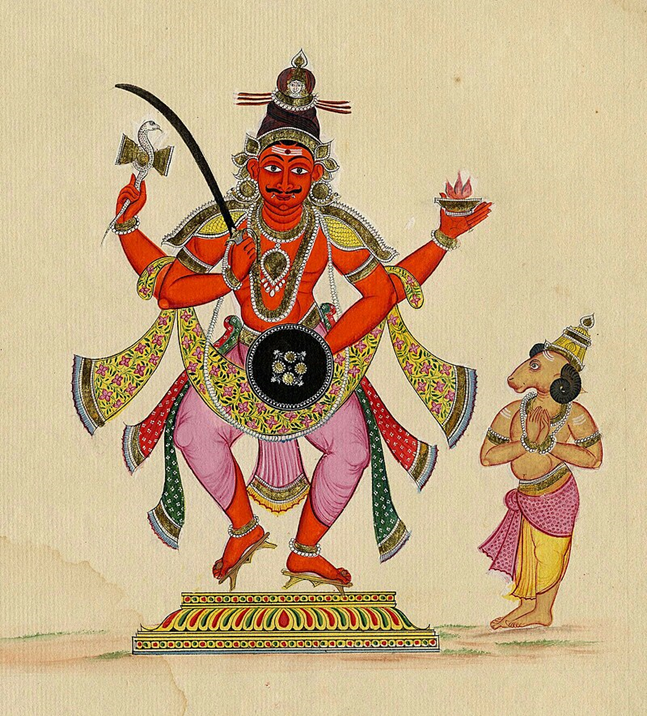
Vīrabhadra, created by Śiva to oversee the passing of an Age, with the vanquished Dakṣa Prajāpati
Mahākāla Bhairava, a fierce manifestation of Śiva, is the ruler of time. The end of Time is the dual (Yama) to life and the subject of a famous dialogue between Naciketā and Death.
The Goddess
Just like Śiva, the Goddess is present everywhere and always. She is the instrument of change both within the individual and in the cosmos. The Goddess is power and movement in three fundamental ways: icchā śakti (will), jñāna śakti (wisdom), and kriyā sakti (action). Beyond these, she is Kālī (Time).

Mahākālī (1980) by Y.G. Srimati (Metropolitan Museum)
Kālī is where time, space and causation disappear, where Time is in the raw, beyond consciousness (which is why Śiva is often shown lying below her feet). Another way of looking at it is that time manifests itself through Goddess Kālī, and Śiva remains beyond reach so long as we are looking out (for he is already within us).
The disheveled hair, for which she is called Muktakeśī speaks to her untrammeled freedom. The garland of skulls or heads which number fifty, and they represent the fifty letters of the alphabet, the manifest state of sound, from which the entire creation may be seen to have proceeded. She is also the creatrix, the Mother, so she reassures her fearstricken children through the abhayamudrā.
Further Reading
Viṣṇu Purāṇa 6.3.14–41 on the dissolution of the universe into Viṣṇu
A Brief Primer on Hinduism
Katha Upanishad, Dialogue between Naciketā and Death
Continue reading...
